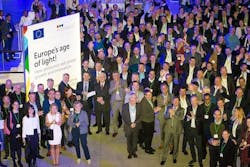Photonics21 hands over European photonics roadmap to EC officials
Held in Brussels, Belgium, the 2019 annual meeting of the Photonics Public Private Partnership (PPP, which is defined by a contract between the Photonics21 Association and the EU Commission in the frame of Horizon 2020), began by highlighting the strong position of European photonics. Photonics, Photonics21 vice president Giorgio Anania in his introduction, is an industry that is growing faster than both the global GDP and that of Europe.
European Photonics remain in a healthy and optimistic position, Anania said, with global leadership in core photonics segments (50% global market share in production technology, 35% global market share in measurement and automated vision and around 30% global market share in optical components, as well as medical technology and life sciences). To maintain this leading position ahead of fierce competition from China and Korea, future European support is of the utmost importance.
Guest speakers
Offering the science perspective to future photonic developments, professor Gérard Mourou shared his insights in his keynote speech, "Extreme light for the benefit of humanity." The 2018 Nobel Prize winner in Physics told delegates that European photonics had an exciting future, with chirped amplification getting rid of nuclear waste on earth and debris in space, as well as in health-care applications making nuclear medicine less expensive and more effective and precise, for example in cancer therapy. Radioactive nuclear energy by-products on earth will one day be transmuted into smaller, manageable, nondangerous compounds by fission reactions, opening up the possibility for "clean nuclear energy," and debris floating around in space will be "zapped" away via future satellites fitted with lasers, Mourou said.
From a political perspective, the EU Commission underlined the role of photonics as a Key Enabling Technology for the future of Europe and gave a clear message that it will support the topic in the next framework program. Deputy Head of Cabinet of Commissioner Gabriel, Carl Buhr, discussed the possibilities that lie ahead for the structuring and administration of photonics funding throughout the next framework. Buhr acknowledged that long processes are to be expected when discussing important funding frameworks like Horizon Europe, which need to include input from EU member states. This time around, member states request that earmarked budgets for PPPs should shrink to a maximum of 50% allocation, with a further 50% remaining open for thematic programmes. Therefore, while financial support for light technologies would not be in question, the funding facilities, Buhr conceded, have not yet been agreed by member states.
With a view from industry, Stefan Traeger, CEO of Jenoptik, had a positive message as far as the current position of light technologies, stating that "Photonics is one of the few [industries] where Europe is leading on a global scale." While European success was based on consistent, methodical approaches to government-funded research, Traeger stressed the importance of academia-industrial partnerships to maintain a world-leading position.
Roadmap, mirror group, synergies
Photonics21 began the official handing over of the new Multiannual Strategic Roadmap, which marked the end of the first day. An essential strategy for European photonics in preparation of Horizon Europe, the roadmap had begun as a consultation process at the 2018 Annual Meeting. The roadmap is the next development from the 2018 Vision Paper "Europe's Age of Light," in which more than 3000 members from more than 1700 companies in the Photonics21 expert community were consulted. On the final day, the activities of the Mirror Group, where member state authorities are represented, and of the first joint Eureka-Photonics21 Mirror Group call for R&D proposals on photonics for advanced manufacturing were outlined by Sebastian Krug. In the future, Photonics21 plans even closer cooperation with other areas, particularly for end users, to speed up time from lab-to-fab on photonics innovation.
A series of speakers from different Public-Private Partnerships, including 5G, European Construction Technology Platform (ECTP), European Technology Platform for High Performance Computing (ETP4HPC), European Cyber Security Organization (ECSO), European Green Vehicles Initiative Association (EGVIA), Electronic Component Systems for European Leadership (ECSEL) and Factories of the Future (FoF), were invited to create discussions and synergies for potential collaborations. The workshop sessions set about defining innovation priorities for the first calls under Horizon Europe throughout 2021-2022.
Source: https://www.photonics21.org/2019/agm-highlights-european-photonics-leading-position
About the Author
John Wallace
Senior Technical Editor (1998-2022)
John Wallace was with Laser Focus World for nearly 25 years, retiring in late June 2022. He obtained a bachelor's degree in mechanical engineering and physics at Rutgers University and a master's in optical engineering at the University of Rochester. Before becoming an editor, John worked as an engineer at RCA, Exxon, Eastman Kodak, and GCA Corporation.

